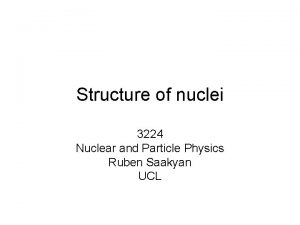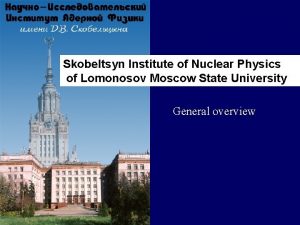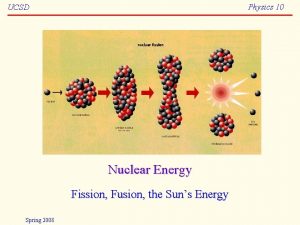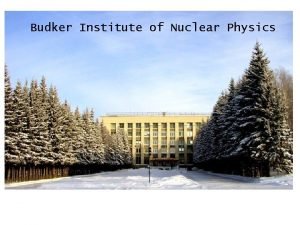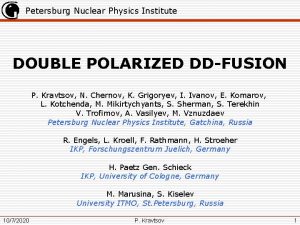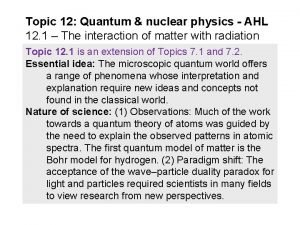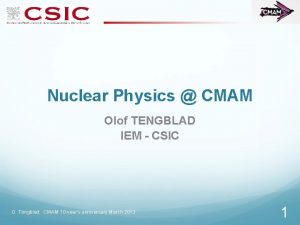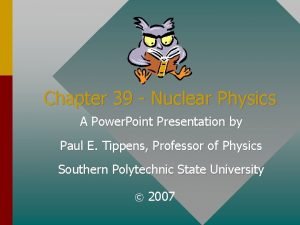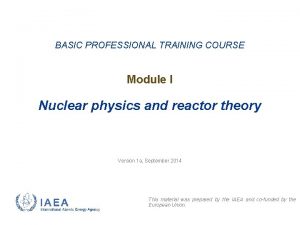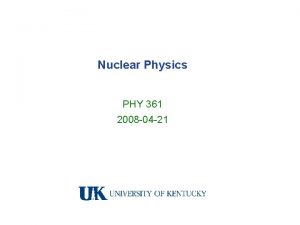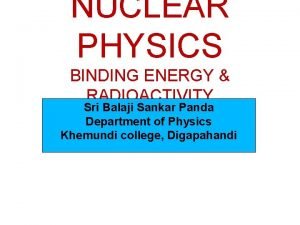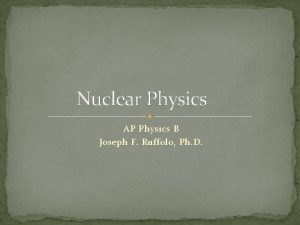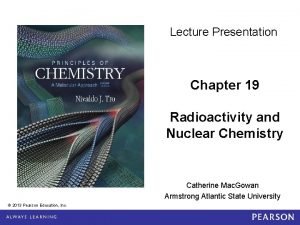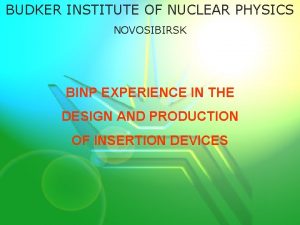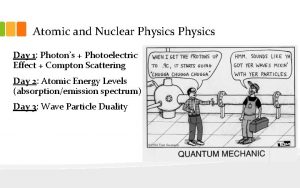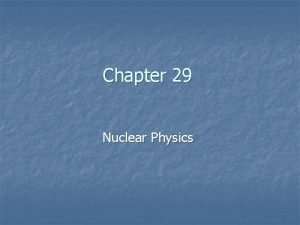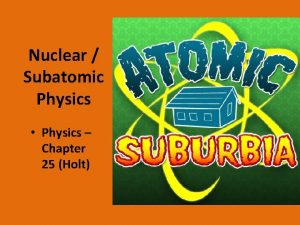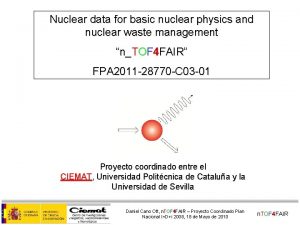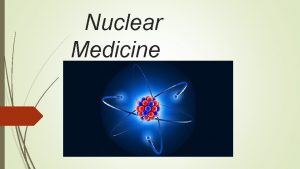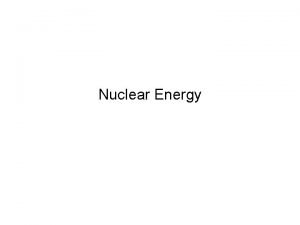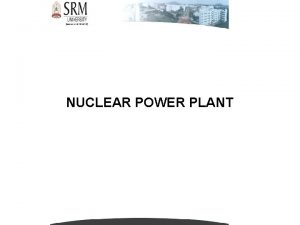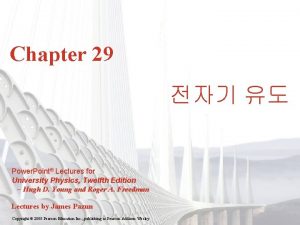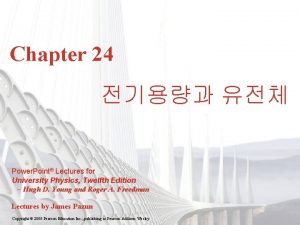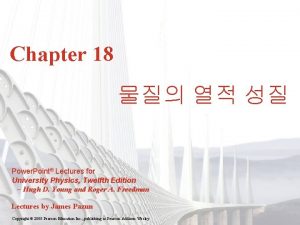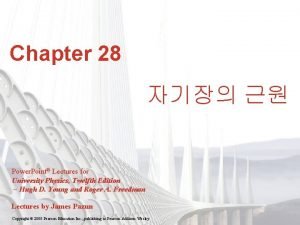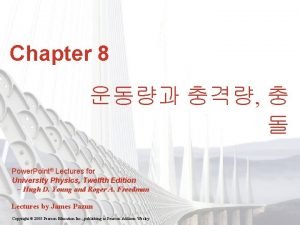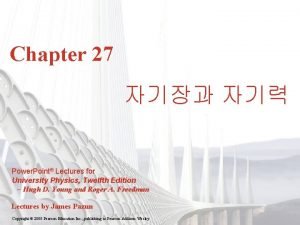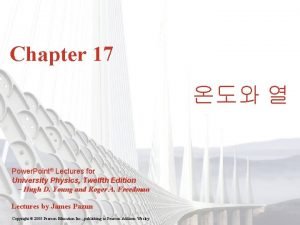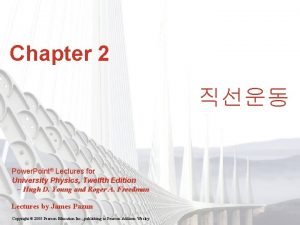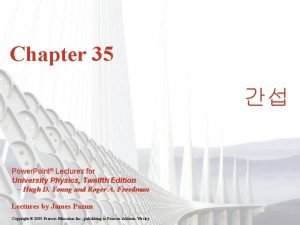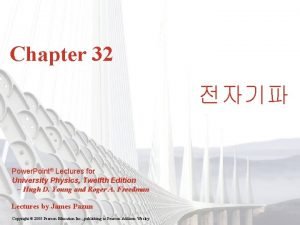Chapter 43 Nuclear Physics Power Point Lectures for

























- Slides: 25

Chapter 43 Nuclear Physics Power. Point® Lectures for University Physics, Thirteenth Edition – Hugh D. Young and Roger A. Freedman Lectures by Wayne Anderson Copyright © 2012 Pearson Education Inc.

Goals for Chapter 43 • To understand some key properties of nuclei • To see how nuclear binding energy depends on the number of protons and neutrons • To investigate radioactive decay • To learn about hazards and medical uses of radiation • To analyze nuclear reactions • To investigate nuclear fission • To understand the nuclear reactions in our sun Copyright © 2012 Pearson Education Inc.

Properties of nuclei • The nucleon number A (also called the mass number) is the total number of protons and neutrons in the nucleus. The nucleon mass is measured in atomic mass units u, slightly less than the mass of the proton: 1 u = 1. 660538782(83) 10 -27 kg. • The radius of most nuclei is given by R = R 0 A 1/3, where R 0 is experimentally determined as R 0 = 1. 2 10 -15 m (1. 2 fm) • All nuclei have approximately the same density. • Example 43. 1: Common iron nuclei have mass number 56. Find the radius, approximate mass, and density of an iron nucleus. Nucleus is 1013 times the density of iron Copyright © 2012 Pearson Education Inc.

Nuclides and isotopes • Electron and nucleon masses (note, a • Proton: mp = 1. 007276 u • Neutron: mn = 1. 008665 u • Electron: me = 0. 000548580 u nucleus is defined to have u = 12. 0000) • The atomic number Z is the number of protons in the nucleus. The neutron number N is the number of neutrons in the nucleus. Therefore A = Z + N. • A nuclide is a single nuclear species having specific values for both Z and N, e. g. • The isotopes of an element have different numbers of neutrons, e. g. Why do you think changing N does not change the element, but changing Z does? • Like electrons, nucleons have ½-integer spin angular momentum, obeying the same relation as before: • The z-component is itself a quantum number, as before: Copyright © 2012 Pearson Education Inc.

Magnetic Moments • Since every nucleon has its own spin, you can imagine that putting them all into a nucleus would make an overall spin of the vector sum of the individual ones, and the result could be pretty chaotic. • In fact, it turns out that the magnitude of the total angular momentum J of the nucleus is also neatly quantized as: with quantized z-component • When A is even, j is an integer, but when A is odd, j is a half-integer. • Associated with the nuclear angular moment is a magnetic moment. Recall the Bohr magneton for electrons: In the case of a nucleus, the analogous quantity is the nuclear magneton: • The z-component of the magnetic moment for the proton is: • Surprisingly, for a neutron it is non-zero: Copyright © 2012 Pearson Education Inc.

Proton Spin Flips • Recall that the potential energy associated with spin is . • Example 43. 2: Proton spin flips: Protons are placed in a 2. 30 -T magnetic field that points in the positive z-direction. (a) What is the energy difference between states with the x-component of proton spin angular momentum parallel and anti -parallel to the field? (b) A proton can make a transition from one of these states to the other by emitting or absorbing a photon with the appropriate energy. Find the frequency and wavelength of such a photon. (a) When the spin angular momentum is parallel to B, When it is anti-parallel, it is just 2. 025 x 10 -7 e. V. The energy difference is just twice this. (b) The corresponding frequency and wavelength are: Copyright © 2012 Pearson Education Inc.

NMR and MRI • Nuclear magnetic resonance and MRI use strong magnetic fields to align the nuclear spins, then flips the spins with radio waves. When the radio waves cease, the spins flip spontaneously and emit radio photons that are measured. Copyright © 2012 Pearson Education Inc.

Nuclear binding energy • The mass of the 12 C atom, made up of 6 protons and 6 neutrons, defines the mass unit u, i. e. it has a mass of exactly 12 u. The individual masses of the protons and neutrons is 6(1. 007276 u) + 6(1. 008665 u) = 12. 095646 u. The difference, 0. 0956 u, when converted to energy E = mc 2, is the binding energy EB of the nucleus. It is convenient to use the mass-energy equivalent of c 2, which is 931. 5 Me. V/u, so that 0. 0956 u => 89. 1 Me. V is the binding energy of 12 C. It is the energy that must be added to separate the nucleons. The quantity EB/c 2 is called the mass defect. • Note that the nucleus is a collection of positive charges, which all mutually repel each other due to the electrostatic force. Therefore, there must another, attractive force acting in the nucleus to overcome this repulsion, and this is called the nuclear strong force. It binds together both protons and neutrons, and is responsible for the drop in energy (mass) of bound nuclei. • The exact nature of this force is still not fully understood, but we can characterize the binding energy as: EB = (ZMH + Nmn – )c 2. Note that MH is the mass of a hydrogen atom, not just its proton, and includes the electrons of the atom. Copyright © 2012 Pearson Education Inc. also

Nuclear binding energy • Example 43. 3: Find the mass defect, total binding energy, and binding energy per nucleon of , which has the highest binding energy per nucleon of all nuclides. The neutral atomic mass of is 61. 928349 u. We have Z = 28, MH = 1. 007825 u, N = A – Z = 34, mn = 1. 008665 u, and = 61. 928349 u. The mass defect is then DM = 0. 585361 u. The corresponding binding energy is just EB = (0. 585361 u)(931. 5 Me. V) = 545 Me. V. The binding energy per nucleon is 545 Me. V/62 = 8. 795 Me. V/nucleon. • At left is the binding energy/nucleon for all nuclides. H has the smallest, but notice that He is unusually stable compared to its neighbors. The peaks show that pairing of nucleons improves binding energy. Copyright © 2012 Pearson Education Inc.

The nuclear force • Important characteristics of the nuclear force: ü It does not depend on charge. Protons and neutrons are bound. It has a short range, of the order of nuclear dimensions. ü Because of its short range, a nucleon only interacts with those in its immediate vicinity. The lack of long-range interaction is called saturation. The electromagnetic force and gravity do not show such saturation. ü It favors binding of pairs of protons or neutrons with opposite spins and with pairs of pairs (a pair of protons and a pair of neutrons, each pair having opposite spins). • Surface tension term Repulsion term N-Z parity term Pairing term We will discuss two models of the nucleus, the liquid-drop model and the shell model. The liquid drop model is phenomenological (no detailed theory for the numbers, only tweaking to make it fit observations). In this model: where C 1 = 15. 75, C 2 = 17. 80, C 3 = 0. 7100, C 4 = 23. 69, C 5 = 39, all in Me. V. Copyright © 2012 Pearson Education Inc.

Nuclear models • For the shell model, we start with the concept of the potential energy function for nucleons. From this perspective, the potential well for protons is shallower than for neutrons (see figure at right). • We can use these potentials to calculate wave functions, which leads to the idea of filled or partially filled shells and subshells, just as for electrons around atoms. Before, we found stable electron configurations for values Z = 2, 10, 18, 36, 54 and 86. • For nuclei, the rules are different because U(r) is different, and also the spin-orbit coupling is much stronger. It is found that N or Z = 2, 8, 20, 28, 50, 82 or 128 are particularly stable. These are called magic numbers. Doubly magic nuclides are: Copyright © 2012 Pearson Education Inc.

Nuclear stability and radioactivity • Radioactivity is the decay of unstable nuclides by the emission of particles and electromagnetic radiation. • Figure 43. 4 (right) is a Segrè chart showing N versus Z for stable nuclides. Notice that as A increases, the stable nuclides leave the N = Z line and prefer more neutrons that protons. This is probably due to the increasing influence of repulsion among the protons. • There are no stable nuclides with A = 5 or 8. The nuclide decays immediately into two He nuclei. • The highest A is 209. There are so-called islands of stability above this. Copyright © 2012 Pearson Education Inc.

Alpha decay • An alpha particle is a 4 He nucleus, which is very stable. Large nuclei can decay by splitting into a smaller nucleus and an alpha particle, e. g. • Alpha decay is possible whenever the parent nuclide is more massive than the sum of the two daughter products, e. g. Example 43. 5: Show that decay is possible in the reaction above, where the Ra isotope is 226. 025403 u, the Rn isotope is 222. 017571 u, and He is 4. 002603 u. The mass difference is (226. 025403 – 222. 017571 – 4. 002602) u = +0. 005229 u The energy equivalent is (0. 005229)(931. 5) Me. V = 4. 871 Me. V. The kinetic energy of the particle can be determined from K = ½ mv 2 = p 2/2 m. The momentum is conserved, so the particle gets 222/(222+4) of the total energy. Copyright © 2012 Pearson Education Inc.

Beta and gamma decay • There are three types of beta decay: beta-minus, beta-plus, and electron capture. • beta-minus decay • beta-plus decay • electron capture • Note the second reaction must take place within a nucleus, or else it is energetically impossible, i. e. it takes external energy (as from an excited nucleus) to make it happen. • A beta-minus – particle is an electron, beta-plus is a positron. • When radium decays to emit an particle, the can have kinetic energy of either 4. 784 Me. V, or 4. 602 Me. V. The latter is due to the product radon nucleus being left in an excited state. The radon nucleus will then relax to the nuclear ground state, and emit a photon of energy 0. 186 Me. V. The photon is called a gamma ray. Copyright © 2012 Pearson Education Inc.

Natural radioactivity • Certain nuclei decay naturally, which is called natural radioactivity. Figure 43. 7 (right) shows a Segrè chart for the 238 U decay series. • Each decay is labeled by a time, called the half-life—note that some are very long (billions of years) and some are extremely short (minutes or seconds). This is related to the potential barrier through which the decay product has to tunnel. Copyright © 2012 Pearson Education Inc.

Activities and half-lives • The half-life is the time for the number of radioactive nuclei to decrease to one-half of their original number. • Because the number of decays is proportional to the number of atoms available to decay, e. g. (the minus sign indicates a loss), the number of remaining nuclei decreases exponentially (see figure at right). The solution to the above equation is found by rearranging and integrating: • To find the half-life, just determine when N = N 0/2, which is when , or • If you start with N 0 nuclei, after 1 half-life you will have N 0/2, and after another half-life you will have N 0/4, etc. • The quantity 1/l is called the mean lifetime. Copyright © 2012 Pearson Education Inc. . An established unit of radiation activity (-d. N/dt) is called the Curie: 1 Ci = 3. 70 x 1010 decay/s. In SI units, 1 decay/s is called the becquerel (Bq).

Activities and half-lives • Example 43. 8: Activity of 57 Co. The isotope 57 Co decays by electron capture to 57 Fe with a half-life of 272 d. The 57 Fe nucleus is produced in an excited state, and it almost instantaneously emits gammy rays that we can detect. (a) Find the mean lifetime and decay constant for 57 Co. (b) If the activity of a 57 Co radiation sources is now 2. 00 m. Ci, how many 57 Co nuclei does the source contain? (c) What will be the activity after 1 year? (a) Since the half-life t 1/2 = ln 2/l = (272 d)(86400 s/d) = 2. 35 107 s, the decay constant is l = ln 2 / 2. 35 107 s = 2. 95 10 -8 s-1. Tmean = 1/l = 3. 39 107 s = 392 d. (b) The activity so N = 7. 4 104 decay/s / 2. 95 10 -8 s-1 = 2. 51 1012 nuclei. (c) After 1 year, the number of nuclei remaining will be The activity will decline by a like factor, or 0. 394 (2. 00 m. Ci) = 0. 788 m. Ci Copyright © 2012 Pearson Education Inc.

Activities and half-lives • Example 43. 9: Radiocarbon Dating. The isotope 14 C decays via beta-minus decay to 14 N with a half-life of 5730 y. Before 1900 the activity per unit mass of atmospheric carbon due to the presence of 14 C averaged about 0. 255 Bq per gram of carbon. (a) What fraction of carbon atoms were 14 C? (b) In analyzing an archaeological specimen containing 500 mg of carbon, you observe 174 decays in one hour. What is the age of the specimen? (a) Since the half-life t 1/2 = ln 2/l = (5730 y)(3. 156 107 s/y) = 1. 808 1011 s, the decay constant is l = ln 2 / 1. 808 1011 s = 3. 83 10 -12 s-1. We get the number of atoms from the activity This is the number of 14 C atoms, but how many C atoms are there in 1 gram (1/12. 011 mol)? Avogadro’s number is 6. 022 1023 atoms/mol, so the total in 1 gram is 6. 022 1023 atoms/mol * 1/12. 011 mol = 5. 01 1022 atoms. The fraction of 14 C atoms was 1. 33 10 -12. (b) The activity when it died would be Now it is 174 decays/3600 s = 0. 048 Bq, or a factor of 0. 379 of what it was. Thus, N(t)/N 0 = 0. 379. The age is then: Copyright © 2012 Pearson Education Inc.

Biological effects of radiation • Follow the text discussion of the biological effects of radiation. • Table 43. 3 gives the RBE for several types of radiation. • Figure 43. 9 shows sources of U. S. radiation exposure. • Follow Example 43. 10 about a medical x ray. Copyright © 2012 Pearson Education Inc.

Nuclear reactions • A nuclear reaction is a rearrangement of nuclear components due to bombardment by a particle rather than a spontaneous natural process. • The difference in masses before and after the reaction corresponds to the reaction energy Q. • Follow Example 43. 11, which looks at exoergic and endoergic reactions. Copyright © 2012 Pearson Education Inc.

Nuclear fission • Nuclear fission is a decay process in which an unstable nucleus splits into two fragments (the fission fragments) of comparable mass. • Figure 43. 11 (right) shows the mass distribution of the fission fragments from the fission of 236 U*. Copyright © 2012 Pearson Education Inc.

Liquid-drop model • The liquid-drop model helps explain fission. See Figure 43. 12 below. • Figure 43. 13 (right) shows the potential energy function of two fission fragments. Copyright © 2012 Pearson Education Inc.

Chain reactions • The neutrons released by fission cause a chain reaction (see Figure 43. 14 below). Copyright © 2012 Pearson Education Inc.

Nuclear reactors • A nuclear reactor is a system in which a controlled nuclear chain reaction is used to liberate energy. • Figure 43. 15 below illustrates a nuclear power plant. • Follow Example 43. 12. Copyright © 2012 Pearson Education Inc.

Nuclear fusion • In a nuclear fusion reaction, two or more light nuclei fuse to form a larger nucleus. • Figure 43. 16 below illustrates the proton-proton chain, which is the main energy source in our sun. • Follow Example 43. 13. Copyright © 2012 Pearson Education Inc.
 Nuclear medicine lectures
Nuclear medicine lectures Frcr physics lectures
Frcr physics lectures Frequency of xrays
Frequency of xrays Power system lectures
Power system lectures Lesson 15 nuclear quest nuclear reactions
Lesson 15 nuclear quest nuclear reactions Fisión nuclear vs fision nuclear
Fisión nuclear vs fision nuclear Ac power formula
Ac power formula Power bi power point
Power bi power point Quantum and nuclear physics
Quantum and nuclear physics Shell model of nucleus
Shell model of nucleus Skobeltsyn institute of nuclear physics
Skobeltsyn institute of nuclear physics Nuclear energy in physics
Nuclear energy in physics Scattering cross section in nuclear physics
Scattering cross section in nuclear physics Budker institute of nuclear physics
Budker institute of nuclear physics Petersburg nuclear physics institute
Petersburg nuclear physics institute Quantum nuclear physics
Quantum nuclear physics Nuclear physics
Nuclear physics Nuclear physics topics for presentation
Nuclear physics topics for presentation Nuclear physics
Nuclear physics Nuclear physics
Nuclear physics Nuclear physics
Nuclear physics Nuclear physics b
Nuclear physics b Nuclear magic numbers
Nuclear magic numbers Nuclear physics
Nuclear physics Budker
Budker Nuclear physics day
Nuclear physics day









